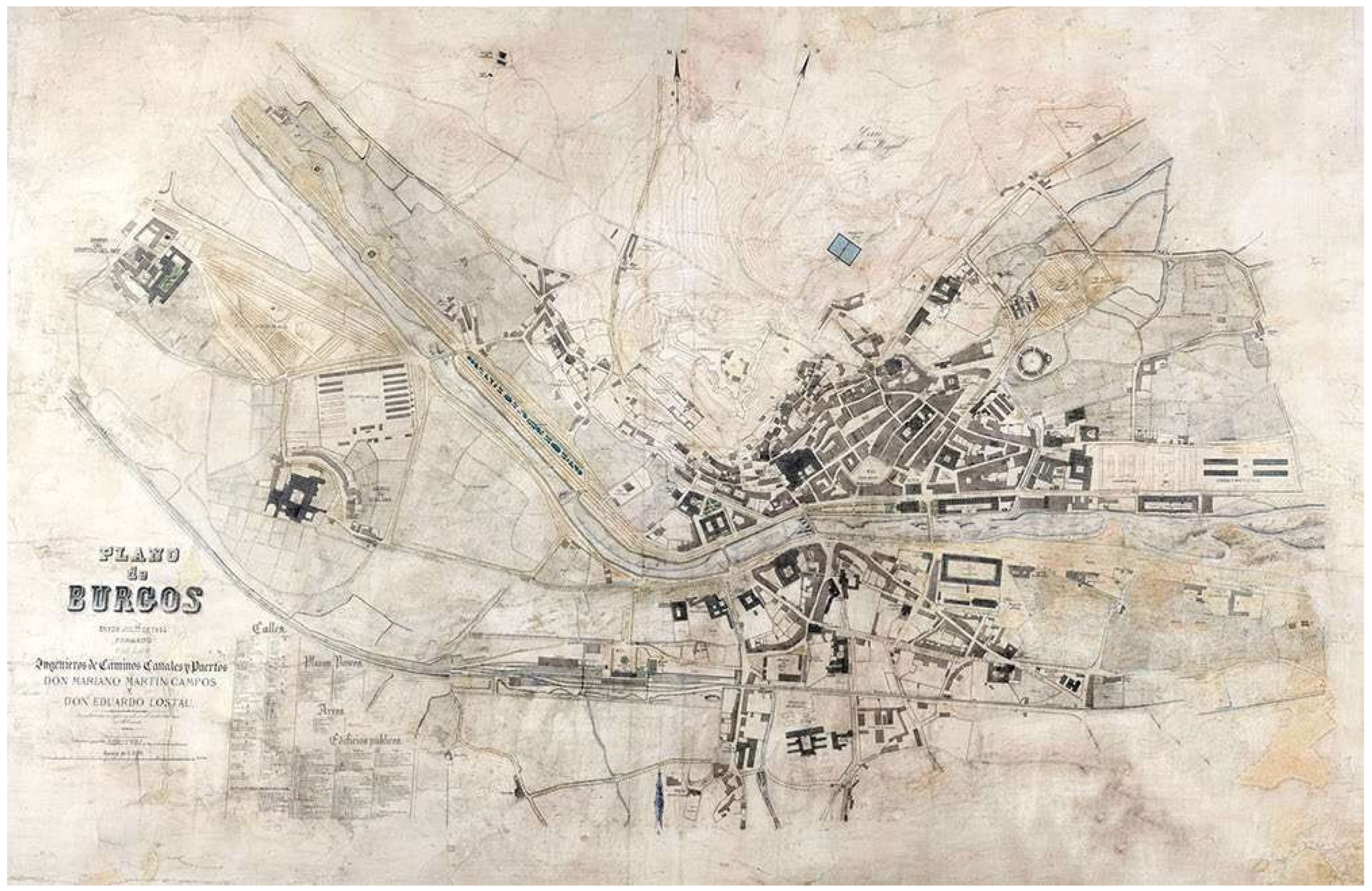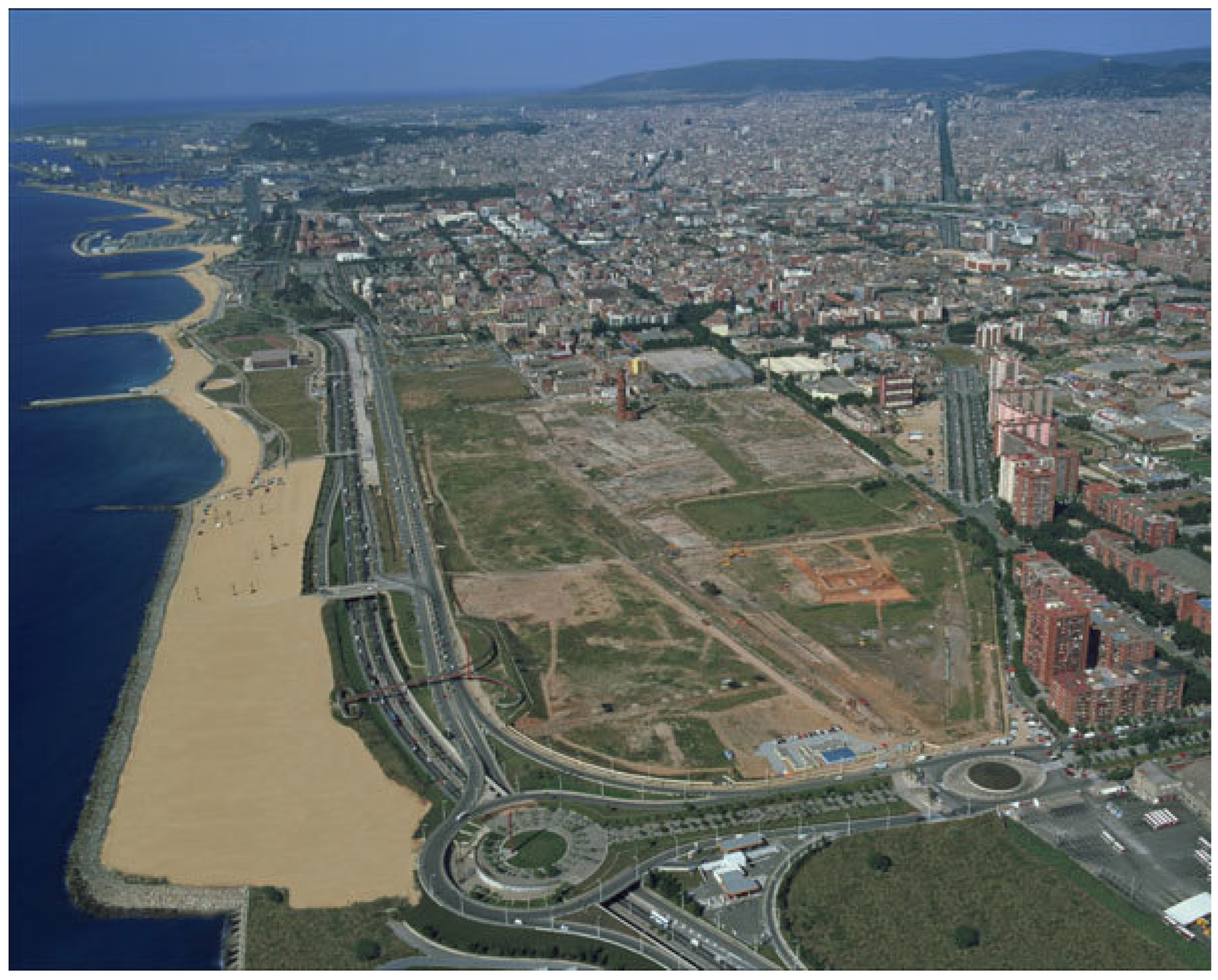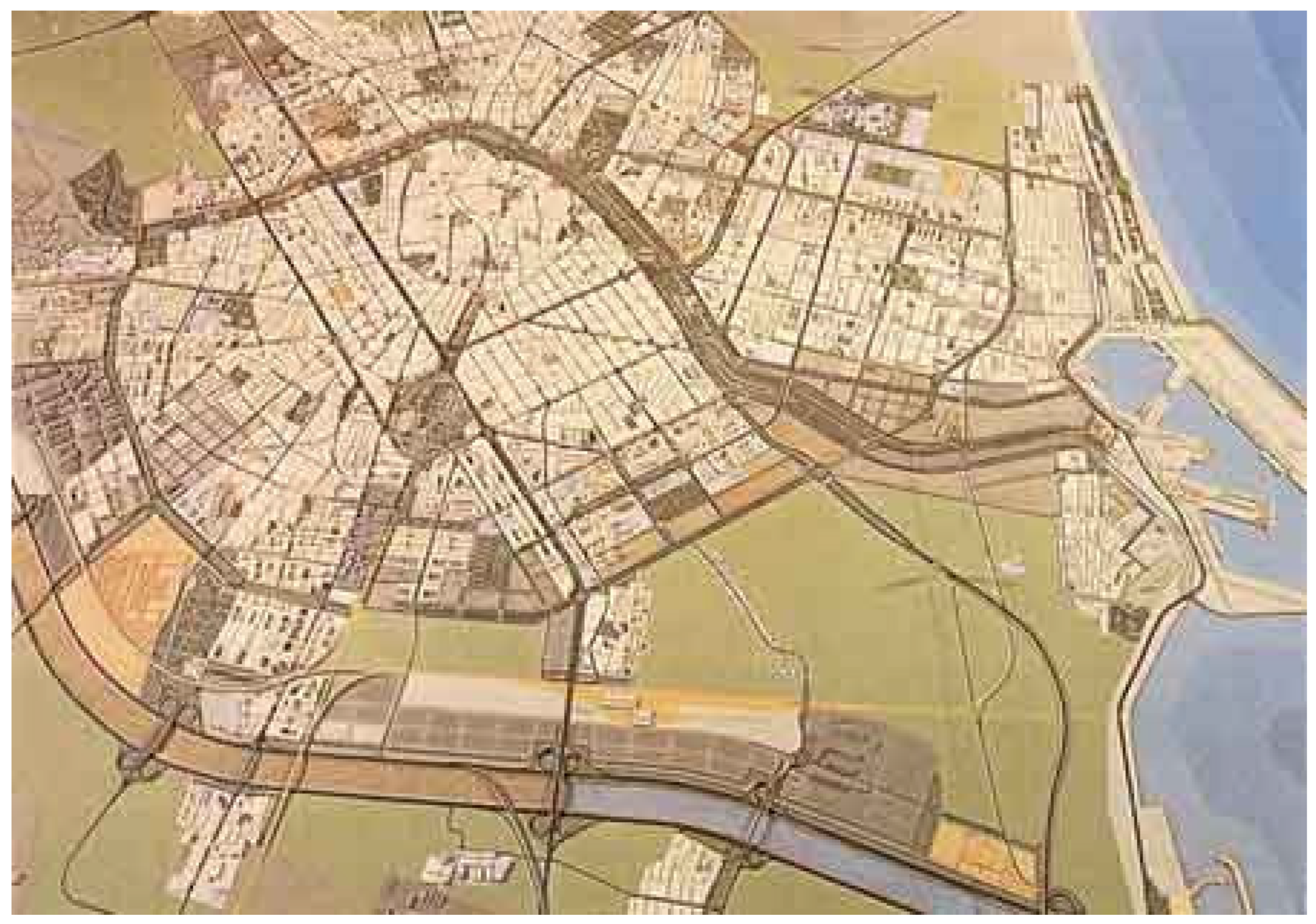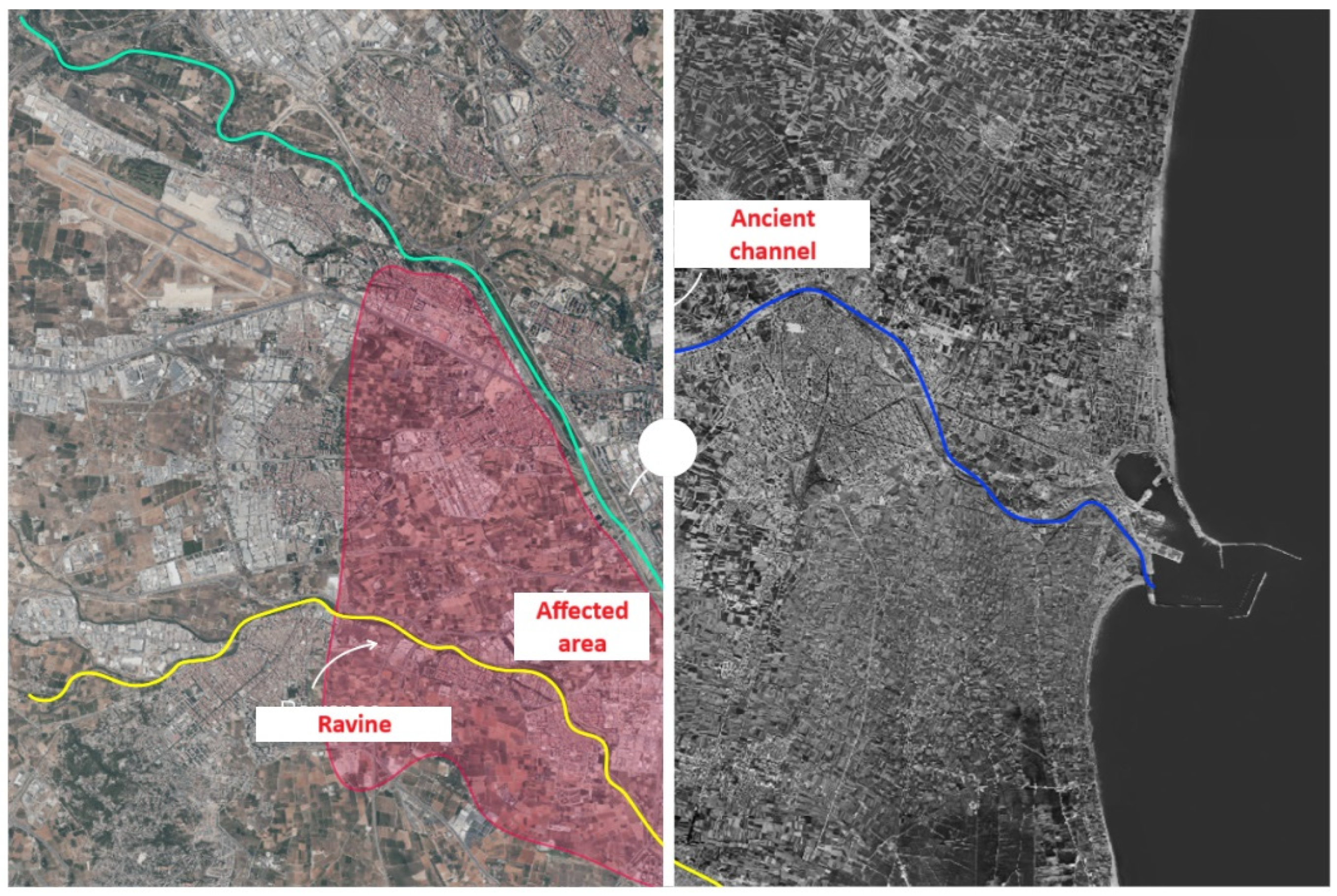The Potential of Blue–Green Infrastructures (BGIs) to Boost Urban Resilience: Examples from Spain
Abstract
1. Introduction
2. The Evolution of BGIs in Spain: From Water Management to Climate Change Issues
- Water Framework Directive (WFD): This directive establishes a comprehensive framework for protecting all water bodies. It encourages natural water retention measures, integral to BGIs, by promoting practices that enhance water infiltration, storage, and purification through natural landscapes. This supports sustainable water resource management and reduces reliance on gray infrastructure, enhancing urban resilience against flooding and drought [19].
- Floods Directive: Aimed at mitigating flood risks, this directive integrates flood risk management plans with natural water management solutions. It emphasizes restoring floodplains and creating green spaces that absorb excess water during heavy rainfall, enhancing the ecological value of urban areas and improving adaptability to climate change [40]. The Intergovernmental Panel on Climate Change (IPCC) highlighted in its Sixth Assessment Report (AR6) that extreme precipitation events will become more common in Europe.
- Habitats Directive and Birds Directive: These directives focus on conserving Europe’s natural habitats and protecting wild fauna and flora (Council of the European Union, 1992 and Council of European Union, 2009). They promote the integration of green infrastructure into urban planning to ensure biodiversity is not compromised by city development. By safeguarding natural habitats and encouraging ecological corridors, these directives support urban environments that coexist with rich biodiversity, a core BGI principle [40,41].
3. The Role of BGIs in Urban Resilience
4. Examples of BGI Projects in Spain
- 1
- Burgos, the pioneer in Spain
- 2
- Madrid: “Landscape of Light”
- 3
- The renewal of Barcelona
- 4
- Turia Gardens (Valencia)
- 5
- Bilbao Green Belt (Bilbao)
5. Conclusions
Funding
Data Availability Statement
Conflicts of Interest
Abbreviations
| BGI | Blue and Green Infrastructure |
| IPCC | Panel on Climate Change |
References
- Heymans, A.; Breadsell, J.; Morrison, G.M.; Byrne, J.J.; Eon, C. Ecological Urban Planning and Design: A Systematic Literature Review. Sustainability 2019, 11, 3723. [Google Scholar] [CrossRef]
- Tellman, B.; Bausch, J.C.; Eakin, H.; Anderies, J.M.; Mazari-Hiriart, M.; Manuel-Navarrete, D.; Redman, C.L. Adaptive Pathways and Coupled Infrastructure: Seven Centuries of Adaptation to Water Risk and the Production of Vulnerability in Mexico City. Ecol. Soc. 2018, 23, 1. [Google Scholar] [CrossRef]
- Polo Martín, B. Floods and Insalubrity as the Trigger for City Restructuring in Spain: The Case of Burgos. UPLanD-J. Urban Plan. Landsc. Environ. Des. 2018, 3, 5–14. [Google Scholar]
- Sánchez-García, C.; Corvacho-Ganahin, O.; Santasusagna Riu Albert, M.; Francos, M. Nature-Based Solutions (NbSs) to Improve Flood Preparedness in Barcelona Metropolitan Area (Northeastern Spain). Hydrology 2024, 11, 213. [Google Scholar] [CrossRef]
- Sánchez-García, C.; Schulte, L. Historical Floods in the Southeastern Iberian Peninsula Since the 16th Century: Trends and Regional Analysis of Extreme Flood Events. Glob. Planet. Chang. 2023, 231, 104317. [Google Scholar] [CrossRef]
- Polo-Martín, B. Valencia’s Battle Against Floods: A Cartographic Review to Assess Water Management Strategies. J. Geogr. Cartogr. 2021, 8, 10129. [Google Scholar] [CrossRef]
- Hays, S.P. The Environmental Movement. J. For. Hist. 1981, 25, 219–221. [Google Scholar] [CrossRef]
- Petchey, O.L.; Gaston, K.J. Functional diversity: Back to basics and looking forward. Ecol. Lett. 2006, 9, 741–758. [Google Scholar] [CrossRef]
- Perrelet, K.; Moretti, M.; Dietzel, A.; Altermatt, F.; Cook, L.M. Engineering Blue-Green Infrastructure for and with Biodiversity in Cities. NPJ Urban Sustain. 2024, 4, 27. [Google Scholar] [CrossRef]
- Keita, K.; Kourouma, S. Blue-Green Infrastructure for Urban Resilience and Sustainability in Developing Countries. In Blue-Green Infrastructure for Sustainable Urban Settlements; Joshi, P.K., Rao, K.S., Bhadouria, R., Tripathi, S., Singh, R., Eds.; Springer: Cham, Switzerland, 2024; pp. 23–45. [Google Scholar] [CrossRef]
- City Council of Portland. ENB-4.19—Green Streets Policy and Green Streets Cross-Bureau Phase 2 Report, Binding City Policies (BCP) BCP-ENB-4.19; City of Portland: Portland, OR, USA, 2007. Available online: https://www.portland.gov/policies/environment-built/sewer-stormwater-erosion-control/enb-419-green-streets-policy-and-green (accessed on 13 February 2025).
- Sightline Institute. Portland’s Street Design Experimentation Creates a Redrawn Paradigm; Sightline Institute: Seattle, WA, USA, 2018; Available online: https://www.sightline.org/2018/08/09/portland-street-design-complete-streets-greenways/ (accessed on 13 February 2025).
- The High Line. New York City Economic Development Corporation. Archived from the Original on September 11, 2014. Retrieved May 19, 2015. Available online: https://www.thehighline.org/ (accessed on 13 February 2025).
- Lucas, P. Revisit: High Line by Diller Scofidio + Renfro and James Corner Field Operations. The Architectural Review, 2024. Available online: https://www.architectural-review.com/essays/revisit/revisit-high-line (accessed on 13 February 2025).
- Iveroth, S.P.; Johansson, S.; Brandt, N. The Potential of the Infrastructural System of Hammarby Sjöstad in Stockholm, Sweden. Energy Policy 2013, 59, 716–726. [Google Scholar] [CrossRef]
- Chung, J.-H.; Hwang, K.Y.; Bae, Y.K. The Loss of Road Capacity and Self-Compliance: Lessons from the Cheonggyecheon Stream Restoration. Transp. Policy 2012, 21, 165–178. [Google Scholar] [CrossRef]
- Ziersen, J.; Clauson-Kaas, J.; Rasmussen, J. The Role of Greater Copenhagen Utility in Implementing the City’s Cloudburst Management Plan. Water Pract. Technol. 2017, 12, 338–343. [Google Scholar] [CrossRef]
- Mell, I.; Scott, A. Definitions and Context of Blue-Green Infrastructure. In ICE Manual of Blue-Green Infrastructure; Institution of Civil Engineers: London, UK, 2023. [Google Scholar]
- Suárez, M.; Gómez-Baggethun, E.; Benayas, J.; Tilbury, D. Towards an Urban Resilience Index: A Case Study in 50 Spanish Cities. Sustainability 2016, 8, 774. [Google Scholar] [CrossRef]
- Meerow, S.; Newell, J.P. Urban Resilience for Whom, What, When, Where, and Why? Urban Geogr. 2019, 40, 309–329. [Google Scholar]
- Zuniga-Teran, A.A.; Gerlak, A.K.; Mayer, B.; Evans, T.P.; Lansey, K.E. Urban Resilience and Green Infrastructure Systems: Towards a Multidimensional Evaluation. Curr. Opin. Environ. Sustain. 2020, 44, 42–47. [Google Scholar] [CrossRef]
- Tierney, K.; Bruneau, M. Conceptualizing and Measuring Resilience: A Key to Disaster Loss Reduction. TR News, 2007; pp. 14–17. Available online: https://trid.trb.org/view/813539 (accessed on 13 February 2025).
- Pakzad, P.; Osmond, P. Developing a Sustainability Indicator Set for Measuring Green Infrastructure Performance. Procedia Soc. Behav. Sci. 2016, 216, 68–79. [Google Scholar]
- OECD. Resilient Cities; OECD: Paris, France, 2020; Available online: https://www.oecd.org/cfe/regional-policy/resilient-cities.htm (accessed on 13 February 2025).
- Zhang, X.; Li, H. Urban Resilience and Urban Sustainability: What We Know and What We Do Not Know? Cities 2018, 72, 141–148. [Google Scholar] [CrossRef]
- Elmqvist, T.; Andersson, E.; Frantzeskaki, N.; McPhearson, T.; Olsson, P.; Gaffney, O.; Takeuchi, K.; Folke, C. Sustainability and Resilience for Transformation in the Urban Century. Nat. Sustain. 2019, 2, 267–273. [Google Scholar]
- Hamlin, C. The Sanitarian Becomes an Authority. 1859. In Proceedings of the International Conference on the History of Public Health and Prevention, Stockholm, Sweden, 9 June–15 September 1991. [Google Scholar]
- Hamlin, C. Predisposing Causes and Public Health in Early Nineteenth Century Medical Thought. Soc. Hist. Med. 1992, 5, 43–70. [Google Scholar] [CrossRef]
- Hildreth, M.L. Doctors, Bureaucrats and Public Health in France, 1888–1902; Garland Publishing Inc.: New York, NY, USA; London, UK, 1987. [Google Scholar]
- Arnould, J. Nouveaux Eléments d’Hygiène; Libr. J.B. Baillière et Fils: Paris, France, 1902; p. 1003. Available online: https://archive.org/stream/BIUSante_90141x1903x49/BIUSante_90141x1903x49_djvu.txt (accessed on 13 February 2025).
- Sussman, G.D. Enlightened Health Reform, Professional Medicine and Traditional Society: The Cantonal Physicians of the Bas-Rhin, 1810–1870. Bull. Hist. Med. 1977, 51, 565–584. [Google Scholar] [CrossRef]
- Pogliano, C. L’Utopia Igienista (1870–1920). In Storia d’Italia. Annali 7. Malattia e Medicina; Della Peruta, F., Ed.; G. Einaudi Editori: Torino, Italy, 1984; pp. 589–631. [Google Scholar]
- Rodríguez Ocaña, E. La Salud Pública en España en el Contexto Europeo, 1890–1925. Rev. Sanid. Hig. Pública 1994, 68, 11–27. [Google Scholar]
- Real Consejo de Sanidad. Cuestiones Fundamentales de Higiene Pública en España; E. Teodoro: Madrid, Spain, 1901. [Google Scholar]
- Hauser, P. Madrid Bajo el Punto de Vista Médico-Social; Ed. del Moral y C. Editora Nacional: Madrid, Spain, 1902. [Google Scholar]
- Capel, H.; Tatjer, M. Reforma Social, Serveis Assistencials i Higienisme a la Barcelona de Final del Segle XIX (1876–1900). In Cent Anys de Salut Pública a Barcelona; Roca Rosell, A., Ed.; Ajuntament de Barcelona: Barcelona, Spain, 1991; pp. 31–73. [Google Scholar]
- Pulido Fernández, A. Sanidad Pública en España y Ministerio Social de las Clases Médicas; Est. Tip. Enrique Teodoro: Madrid, Spain, 1902. [Google Scholar]
- Faus Prieto, A. Las Ciudades de Valencia Ante las Riadas del Turia de 1776. Cuad. Geogr. 1999, 65–66, 122–123. [Google Scholar]
- Hauser, P. Geografía Médica de la Península Ibérica; Eduardo Arias: Madrid, Spain, 1913; pp. 235–236. [Google Scholar]
- Meerow, S.; Newell, J.P. Spatial Planning for Multifunctional Green Infrastructure: Growing Resilience in Detroit. Landsc. Urban Plan. 2017, 159, 62–75. [Google Scholar] [CrossRef]
- Olcina, J.; Sauri, D.; Hernández, M.; Ribas, A. Flood Policy in Spain: A Review for the Period 1983–2013. Disaster Prev. Manag. 2016, 25, 41–58. [Google Scholar]
- Water Framework Directive (2000/60/EC). Directive 2000/60/EC of the European Parliament and of the Council establishing a framework for the Community action in the field of water policy. Off. J. Eur. Communities 2000, L327, 1–73. Available online: https://eur-lex.europa.eu/legal-content/EN/TXT/?uri=CELEX%3A32000L0060 (accessed on 13 February 2025).
- European Environmental Agency. Directiva 2007/60/CE del Parlamento Europeo y del Consejo de 23 de Octubre de 2007 sobre la Evaluación y la Gestión de los Riesgos de Inundación. D. Of. Unión Eur. 2007, L288, 27–34. Available online: https://eur-lex.europa.eu/legal-content/ES/TXT/?uri=CELEX%3A32007L0060 (accessed on 13 February 2025).
- Council of the European Union. Council Directive 92/43/EEC of 21 May 1992 on the Conservation of Natural Habitats and of Wild Fauna and Flora. Off. J. Eur. Communities 1992, L206, 7–50. Available online: https://eur-lex.europa.eu/legal-content/EN/TXT/?uri=CELEX%3A31992L0043 (accessed on 13 February 2025).
- Voulvoulis, N.; Arpon, K.D.; Giakoumis, T. The EU Water Framework Directive: From Great Expectations to Problems with Implementation. Sci. Total Environ. 2017, 575, 358–366. [Google Scholar] [CrossRef]
- WWF & EEB. ‘Tips and Tricks’ for Water Framework Directive Implementation: A Resource Document for Environmental NGOs on the EU Guidance for the Implementation of the Water Framework Directive. 2004. Available online: http://www.rivernet.org/general/docs/200403_EEB_WWF_Tips&Tricks.pdf (accessed on 13 February 2025).
- Santato, S.; Bender, S.; Schaller, M. The European Floods Directive and Opportunities Offered by Land Use Planning; CSC Report 12; Climate Service Center: Hamburg, Germany, 2013. [Google Scholar]
- Mikša, K.; Kalinauskas, M.; Inácio, M.; Pereira, P. Implementation of the European Union Floods Directive—Requirements and National Transposition and Practical Application: Lithuanian Case-Study. Land Use Policy 2021, 100, 104924. [Google Scholar] [CrossRef]
- Council of the European Union. Directive 2009/147/EC of the European Parliament and of the Council of 30 November 2009 on the Conservation of Wild Birds. Off. J. Eur. Union 2009, L20, 7–25. Available online: https://eur-lex.europa.eu/eli/dir/2009/147/oj/eng (accessed on 13 February 2025).
- Leichenko, R. Climate Change and Urban Resilience. Curr. Opin. Environ. Sustain. 2011, 3, 164–168. [Google Scholar] [CrossRef]
- Pike, A.; Dawley, S.; Tomaney, J. Resilience, Adaptation and Adaptability. Camb. J. Reg. Econ. Soc. 2010, 3, 59–70. [Google Scholar] [CrossRef]
- Barroca-Paccard, M.; Barroca, B. Importance of Biodiversity for Urban Resilience; European Geosciences Union General Assembly: Vienna, Austria, 2011. [Google Scholar]
- Suárez, M.; Benayas, J.; Justel, A.; Sisto, R.; Montes, C.; Sanz-Casado, E. A holistic index-based framework to assess urban resilience: Application to the Madrid Region, Spain. Ecol. Indic. 2024, 166, 112293. [Google Scholar] [CrossRef]
- Pendall, R.; Foster, K.; Cowell, M. Resilience and Regions: Building Understanding of the Metaphor. Camb. J. Reg. Econ. Soc. 2010, 3, 71–84. [Google Scholar]
- Staddon, C.; De Vito, L.; Zuniga-Teran, A.; Schoeman, Y.; Hart, A.; Booth, G. Contributions of Green Infrastructure to Enhancing Urban Resilience. The Resilience Shift: Agenda Setting Scoping Studies. 2017, p. 19. Available online: https://resilienceshift.org (accessed on 13 February 2025).
- Charlesworth, S.; Booth, C.; Warwick, F.; Lashford, C.; Lade, O. Chapter 12: Rainwater Harvesting-Reaping a Free and Plentiful Supply of Water. In Water Resources in the Built Environment: Management Issues and Solutions; Booth, C., Charlesworth, S., Eds.; John Wiley & Sons, Inc.: Hoboken, NJ, USA, 2014. [Google Scholar]
- Kumar, P.; Debele, S.E.; Khalili, S.; Halios, C.H.; Sahani, J.; Aghamohammadi, N.; Andrade, M.d.F.; Athanassiadou, M.; Bhui, K.; Calvillo, N.; et al. Urban Heat Mitigation by Green and Blue Infrastructure: Drivers, Effectiveness, and Future Needs. Innovation 2024, 5, 100588. [Google Scholar] [CrossRef]
- Jia, S.; Wang, Y. Comparison of Different Blue–Green Infrastructure Strategies in Mitigating Urban Heat Island Effects and Improving Thermal Comfort. In Proceedings of the Construction Research Congress 2022, Arlington, VA, USA, 9–12 March 2022. [Google Scholar]
- Antoszewski, P.; Świerk, D.; Krzyżaniak, M. Statistical Review of Quality Parameters of Blue-Green Infrastructure Elements Important in Mitigating the Effect of the Urban Heat Island in the Temperate Climate (C) Zone. Int. J. Environ. Res. Public Health 2020, 17, 7093. [Google Scholar] [CrossRef]
- Lamond, J.; Everett, G. Sustainable Blue-Green Infrastructure: A Social Practice Approach to Understanding Community Preferences and Stewardship. Landsc. Urban Plan. 2019, 191, 103639. [Google Scholar] [CrossRef]
- Verschuuren, J.M. Implementation of the Convention on Biodiversity in Europe: 10 Years of Experience with the Habitats Directive. J. Int. Wildl. Law Policy 2002, 5, 251–267. [Google Scholar] [CrossRef]
- Wu, Y.; Wei, Y.D.; Liu, M.; García, I. Green Infrastructure Inequality in the Context of COVID-19: Taking Parks and Trails as Examples. Urban For. Urban Green. 2023, 86, 128027. [Google Scholar] [CrossRef]
- Mell, I.; Whitten, M. Access to Nature in a Post COVID-19 World: Opportunities for Green Infrastructure Financing, Distribution, and Equitability in Urban Planning. Int. J. Environ. Res. Public Health 2021, 18, 1527. [Google Scholar] [CrossRef]
- Wu, W.; Chen, W.Y. Inequalities of Green Infrastructure in the Context of Healthy and Resilient Cities. Urban For. Urban Green. 2024, 94, 128244. [Google Scholar] [CrossRef]
- Anguelovski, I.; Connolly, J.J.T.; Pearsall, H.; Roberts, J.T.; Shokry, G.; Checker, M.; Maantay, J.; Gould, K.; Lewis, T.; Maroko, A. Why Green “Climate Gentrification” Threatens Poor and Vulnerable Populations. Proc. Natl. Acad. Sci. USA 2019, 116, 26139–26143. [Google Scholar] [CrossRef]
- Anguelovski, I.; Connolly, J.J.T.; Cole, H.; Garcia-Lamarca, M.; Triguero-Mas, M.; Baró, F.; Martin, N.; Conesa, D.; Shokry, G.; Pérez del Pulgar, C.; et al. Green Gentrification in European and North American Cities. Nat. Commun. 2022, 13, 3816. [Google Scholar] [CrossRef] [PubMed]
- Solís Ruiz, J. Las Inundaciones en la Sevilla Contemporánea (1801–2015); Diputación de Sevilla: Sevilla, Spain, 2022. [Google Scholar]
- ABM. Proyecto Constructivo y Dirección de Obra Para la Conectividad del río Ter. Available online: https://www.abm.cat/es/proj/proyecto-constructivo-direccion-obra-conectividad-rio-ter/ (accessed on 13 February 2025).
- Estrella Sevilla, E.; García-Ayllón Veintimilla, S. La evolución urbana de la ciudad de Murcia en relación con el río Segura. Rev. Obras Públicas 2012, 159, 69–82. [Google Scholar]
- Confederación Hidrográfica del Segura (CHS). La CHS Aprueba el Proyecto de Recuperación Ambiental del Río Segura a su Paso por Murcia. Available online: https://www.chsegura.es/en/confederacion/prensa-publicaciones-y-difusion/noticias/La-CHS-aprueba-el-proyecto-de-recuperacion-ambiental-del-rio-Segura-a-su-paso-por-Murcia/ (accessed on 13 February 2025).
- Pellicer-Martínez, F.; Martínez-Paz, J.M. Análisis Coste-Beneficio de la Recuperación Ambiental del río Segura. II Jornadas de Inicio a la Investigación de Estudiantes de la Facultad de Biología. 2020. Available online: http://hdl.handle.net/10201/89647 (accessed on 13 February 2025).
- Ministerio Para la Transición Ecológica y el Reto Demográfico (MITECO). Proyecto de Mejora de la Resiliencia a las Inundaciones en el Río. Available online: https://www.miteco.gob.es/es/agua/temas/delimitacion-y-restauracion-del-dominio-publico-hidraulico/estrategia-nacional-restauracion-rios/programa-de-restauracion-y-adaptacion-al-cambio-climatico/actuaciones-2024/proyecto-de-mejora-de-la-resiliencia-a-las-inundaciones-en-el-ri0.html (accessed on 13 February 2025).
- Ebro Resilience. Permeabilización del Azud de Pina de Ebro (Zaragoza). Available online: https://www.ebroresilience.com/ebro-resilience-permeabilizacion-azud-de-pina-ebro-zaragoza/ (accessed on 13 February 2025).
- AUVA 2030. Renaturalización de los Ríos Pisuerga y Esgueva. Available online: https://auva2030.es/1-2-renaturalizacion-rios-pisuerga-y-esgueva/ (accessed on 13 February 2025).
- Donostia Futura. Plan Estratégico San Sebastián 2004–2010. Available online: https://www.donostiafutura.com/media/uploads/Plan-Estrategico-SS-2004_2010.pdf (accessed on 13 February 2025).
- Ayuntamiento de Donostia-San Sebastián. Plan de Adaptación al Cambio Climático 2020. Available online: https://www.donostia.eus/ataria/documents/d/ingurumena/plan-de-adaptacion_2020 (accessed on 13 February 2025).
- Mijic, A.; Brown, K. Integrating Green and Blue Spaces into Our Cities: Making it Happen; Imperial College: London, UK, 2019. [Google Scholar] [CrossRef]
- Ayuntamiento de Madrid. Memoria de Gestión 2006; Ayuntamiento de Madrid, Área de Gobierno de Urbanismo y Vivienda: Madrid, Spain, 2006; Available online: https://www.madrid.es/UnidadesDescentralizadas/UrbanismoyVivienda/Urbanismo/MemoriaDeGestion2006/ActuacionesSingulares/Ficheros/C05.pdf (accessed on 13 February 2025).
- Ayuntamiento de Madrid. Plan Director de Rehabilitación del Entorno del Río Manzanares; Ayuntamiento de Madrid, Área de Gobierno de Urbanismo y Vivienda, AUIA, Arquitectos Urbanistas Ingenieros Asociados, S.L.P.: Madrid, Spain, 2010. [Google Scholar]
- Brandis García, D. Grandes Proyectos Urbanos y Desarrollos Residenciales: Del Urbanismo de Mercado a un Nuevo Modelo para Madrid. Ciudad Territ. Estud. Territ. 2018, 198, 729–745. [Google Scholar]
- Perini, K. Chapter 9.3. Madrid Río, Spain–Strategies and Techniques. In Urban Sustainability and River Restoration; Wiley & Sons Ltd.: Hoboken, NJ, USA, 2016; pp. 117–126. ISBN 9781119245025. [Google Scholar] [CrossRef]
- Burgos, F.; Garrido, G.; Porras-Isla, F. Madrid Río: Un Proyecto de Transformación Urbana; Turner: Sydney, Australia, 2011. [Google Scholar]
- Burgos, F.; Garrido, G.; Porras-Isla, F. Paisajes en la Ciudad, Madrid Río: Geografía, Infraestructura y Espacio Público; Turner: Sydney, Australia, 2014; ISBN 978-84-15832-41-6. [Google Scholar]
- Galiana Martín, L.; Vinuesa Angulo, J. Descentralización y Recentralización en Espacios Metropolitanos Maduros: El Caso de Madrid. In Metrópolis. Dinámicas Urbanas; Varela, B., Vinuesa, J., Eds.; Universidad Autónoma de Madrid–Universidad de Luján: Madrid, Spain, 2012; pp. 23–48. [Google Scholar]
- Galiana Martín, L. La Operación Madrid Río y sus Efectos en Términos de Selección Socio-Demográfica. Investig. Geogr. 2022, 78, 215–238. [Google Scholar] [CrossRef]
- Garrido Colmenero, G. Madrid Río, o el Retorno de la Urbe a la Geografía del Manzanares. PH Bol. Inst. Andal. Patrim. Hist. 2017, 25, 100–117. [Google Scholar] [CrossRef]
- Armas-Díaz, A.; Ortiz, A.; Calero Martín, C.G.; Delgado Acosta, C.R. El Parque de Diagonal Mar de Barcelona: Entre el Diseño, la Sostenibilidad Ambiental y el Uso Social. In Espacios Públicos, Género y Diversidad. Geografías Para Unas Ciudades Inclusivas; García Ramón, M.D., Ortiz Guitart, A., Prats Ferret, M., Eds.; Icaria: Barcelona, Spain, 2014; Chapter IX. [Google Scholar]
- Camerin, F. From “Ribera Plan” to “Diagonal Mar”, Passing through 1992 “Vila Olímpica”: How Urban Renewal Took Place as Urban Regeneration in Poblenou District (Barcelona). Land Use Policy 2019, 89, 104226. [Google Scholar] [CrossRef]
- Agència Catalana de l’Aigua. Planificació Fluvial de la Conca del Riu Besòs. 2011. Available online: http://aca-web.gencat.cat (accessed on 13 February 2025).
- ISGlobal. “La Regeneración del río Besòs Reporta Beneficios para la Salud y Ahorro para el Sistema Sanitario”. ISGlobal. 2019. Available online: https://www.isglobal.org/en/-/la-regeneracion-del-rio-besos-reporta-beneficios-para-la-salud-y-ahorro-para-el-sistema-sanitario (accessed on 13 February 2025).
- Vert, C.; Carrasco-Turigas, G.; Zijlema, W.; Gascon, M.; Espinosa, A.; Cano-Riu, L.; Elliott, L.R.; Litt, J.; Nieuwenhuijsen, M.J. Impact of a riverside accessibility intervention on use, physical activity, and wellbeing: A mixed methods pre-post evaluation. Landsc. Urban Plan. 2019, 190, 103611. [Google Scholar] [CrossRef]
- Díaz, A.; Martín-Vide, J.; Noguera, B.; Alarcón, A.; Salgot, M. Recursos Hídricos y Cambio Climático: El Caso del río Besòs. Aproximación Socioeconómica; International Conference on Regional Science, Universidad de Barcelona: Barcelona, Spain, 2016. [Google Scholar]
- Martín-Vide, J.P. Restauración del río Besòs en Barcelona. Historia y lecciones aprendidas. Ribagua 2015, 2, 51–60. [Google Scholar] [CrossRef][Green Version]
- Pérez Puche, F. Hasta Aquí Llegó la Riada; Ayuntamiento de Valencia: Valencia, Spain, 1997. [Google Scholar]
- Selva Royo, J.R. Fernando Martínez García-Ordóñez. Trayectoria Profesional. In ViA Arquitectura. Premios 2005–2006; Colegio Oficial de Arquitectos de la Comunidad Valenciana: Valencia, Spain, 2007. [Google Scholar]
- García Heredia, A. Principio y Fin del Área Metropolitana de Valencia. De la Autarquía a la Democracia. In Historia de la Ciudad V. Tradición y Progreso; ÍCARO (Colegio Territorial de Arquitectos de Valencia): Valencia, Spain, 2008. [Google Scholar]
- Peñín Ibáñez, A. Valencia 1874–1959. Ciudad, Arquitectura y Arquitectos; Escuela Técnica Superior de Arquitectura de Valencia: Valencia, Spain, 1978. [Google Scholar]
- García-Ordóñez, F.M. Un Plan Regional: Nueva Valencia; Nuestro Tiempo: Pamplona, Spain, 1958; p. 45. [Google Scholar]
- García-Ordóñez, F.M. La Renovación Urbana en Valencia. In Boletín Informativo y Cultural del Ateneo Mercantil; 1959. [Google Scholar]
- Larrodera López, E.; García Ordóñez, F.M. Planes Generales con Aplicación al Plan General de Valencia. Sesión de Estudio para el 1er Congreso Nacional de Urbanismo “La Gestión Urbanística”; Ministerio de la Vivienda, Secretaría General Técnica: Barcelona, Spain, 1962. [Google Scholar]
- Selva Royo, J.R. 29+1. La Ordenación Urbanística Metropolitana de Gran Valencia (1947–1986). Ph.D. Thesis, Departament d’Urbanisme i Ordenació del Territori, Universitat Politècnica de Catalunya, Barcelona, Spain, 2014. [Google Scholar]
- Selva Royo, J.S. Antecedentes y Formación del Plan General de Valencia de 1966. Cuad. Investig. Urban. 2014, 97, 1–63. [Google Scholar] [CrossRef][Green Version]
- Carmona González, P.; Olmos Llórens, J. Río y Ciudad: El Caso de Valencia. Rev. Col. Ing. Caminos Canales Puertos 1994, 28. [Google Scholar]
- Rivera Nebot, A. (MARADENTRO). In Riada en Valencia, Octubre 1957; 2024. [Google Scholar]
- Ajuntament de València. La Valencia de los Noventa. Una Ciudad con Futuro; Ajuntament de València: Valencia, Spain, 1987. [Google Scholar]
- Llopis Alonso, A. El Jardín del Turia: Otros Tiempos, Otros Proyectos, Otras Imágenes. In Historia de la Ciudad VI. Proyecto y Complejidad; ÍCARO (Colegio Territorial de Arquitectos de Valencia): Valencia, Spain, 2010. [Google Scholar]
- Casado-Arzuaga, I.; Madariaga, I.; Onaindia, M. Perception, Demand, and User Contribution to Ecosystem Services in the Bilbao Metropolitan Greenbelt. J. Environ. Manag. 2013, 129, 33–43. [Google Scholar] [CrossRef] [PubMed]
- Scholte, S.S.K.; van Teeffelen, A.J.A.; Verburg, P.H. Integrating Socio-Cultural Perspectives into Ecosystem Service Valuation: A Review of Concepts and Methods. Ecol. Econ. 2015, 114, 67–78. [Google Scholar] [CrossRef]
- Kothencz, G.; Kolcsár, R.; Cabrera-Barona, P.; Szilassi, P. Urban Green Space Perception and Its Contribution to Well-Being. Int. J. Environ. Res. Public Health 2017, 14, 766. [Google Scholar] [CrossRef]
- Deia. Nuevos Corredores Verdes para Conectar Parques en Bilbao. 2025. Available online: https://www.deia.eus/bilbao/2025/03/11/nuevos-corredores-verdes-conectar-parques-bilbao-9379494.html.4o (accessed on 13 February 2025).









| Dimension | Criteria | Description |
|---|---|---|
| Hydrological Resilience | Flood Risk Reduction | Measures flood frequency, water absorption capacity, and stormwater management. |
| Water Resource Management | Evaluates sustainable water supply, reservoirs, and efficiency of drainage systems. | |
| Climate Resilience | Urban Heat Island Mitigation | Assesses tree canopy coverage, temperature regulation, and green space availability. |
| Air Quality Improvement | Tracks pollution levels and green infrastructure contributions to air purification. | |
| Urban Planning and Infrastructure Resilience | Sustainable Mobility | Considers pedestrian-friendly spaces, bike lanes, and public transportation expansion. |
| Land Use and Development | Evaluates zoning regulations, mixed-use development, and disaster-proof urban design. | |
| Social and Institutional Resilience | Equitable Green Space Access | Measures distribution of parks and nature-based solutions across socio-economic groups. |
| Governance and Community Engagement | Assesses city policies, multi-sector collaboration, and citizen participation in resilience initiatives. | |
| Economic Resilience | Investment in Sustainable Development | Evaluates funding for resilience projects and economic benefits of green infrastructure. |
| Employment and Innovation | Measures job creation in sustainability sectors and technological advancements in resilience planning. |
Disclaimer/Publisher’s Note: The statements, opinions and data contained in all publications are solely those of the individual author(s) and contributor(s) and not of MDPI and/or the editor(s). MDPI and/or the editor(s) disclaim responsibility for any injury to people or property resulting from any ideas, methods, instructions or products referred to in the content. |
© 2025 by the author. Licensee MDPI, Basel, Switzerland. This article is an open access article distributed under the terms and conditions of the Creative Commons Attribution (CC BY) license (https://creativecommons.org/licenses/by/4.0/).
Share and Cite
Polo-Martín, B. The Potential of Blue–Green Infrastructures (BGIs) to Boost Urban Resilience: Examples from Spain. Urban Sci. 2025, 9, 102. https://doi.org/10.3390/urbansci9040102
Polo-Martín B. The Potential of Blue–Green Infrastructures (BGIs) to Boost Urban Resilience: Examples from Spain. Urban Science. 2025; 9(4):102. https://doi.org/10.3390/urbansci9040102
Chicago/Turabian StylePolo-Martín, Bárbara. 2025. "The Potential of Blue–Green Infrastructures (BGIs) to Boost Urban Resilience: Examples from Spain" Urban Science 9, no. 4: 102. https://doi.org/10.3390/urbansci9040102
APA StylePolo-Martín, B. (2025). The Potential of Blue–Green Infrastructures (BGIs) to Boost Urban Resilience: Examples from Spain. Urban Science, 9(4), 102. https://doi.org/10.3390/urbansci9040102






